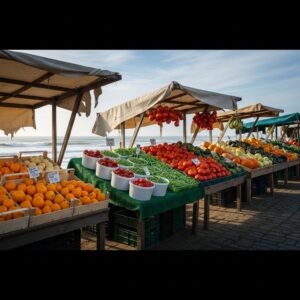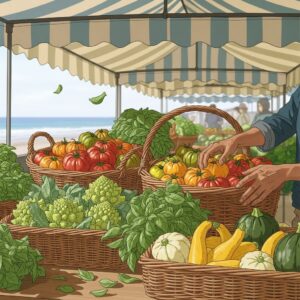There’s a special kind of brightness to Malibu produce, the kind you notice when you slice into a late‑season tomato or tear a handful of herbs just as the afternoon wind changes. Organic shopping here is as much about flavor and texture as it is about farming practices, and the coastline’s microclimates give you options all year long. From the Civic Center to Point Dume and out to Trancas, markets lean into crisp greens, fragrant citrus, and a steady rotation of seasonal favorites. When you align your cart with those rhythms, meals come together quickly and taste like they belong to the place. If you enjoy a small push toward what’s peaking, scanning current weekly deals can nudge your list toward the brightest picks without complicating your day.
Organic means different things to different people. For some, it’s about avoiding certain inputs; for others, it’s about soil health and the ecosystems around the farm. In Malibu, proximity to fertile valleys and coastal foothills brings a steady stream of options that feel close to the source. That closeness shows up on the plate—lettuces that stay crisp, herbs that smell like the garden, and fruit that tastes like it was meant for the breeze coming off the water.
How to choose organic produce like a local
Start with your senses. Good organic produce looks alive: leaves stand tall, stems snap, and colors have depth. For leafy greens, the core should be moist but not soggy; for root vegetables, skin should be taut without excessive cuts. With berries, turn the clamshell gently and check for dryness and bright color. A few seconds of attention saves you a day or two of shelf life.
Smell tells the truth. Ripe peaches and melons have a scent that hints at what you’ll taste. Citrus shouldn’t be oily to the touch but should feel dense; density means juice. For avocados, choose a mix of ripeness stages. Pick one that yields lightly for tonight and a couple that are firmer for later in the week. Your future self will thank you.
Seasonal cycles along the coast
Spring bursts with strawberries, tender greens, and herbs ready to be tossed into everything. Early summer brings cherries, stone fruit, and delicate squash; high summer sings with tomatoes, corn, melons, and basil that practically perfumes the kitchen. As the days shorten, citrus and sturdy greens take the stage. In winter, you’ll find a festival of oranges, mandarins, and grapefruits alongside hardy roots and brassicas. Malibu’s light and air amplify these cycles—you’ll feel them in your cooking even if you don’t set out to.
Lean into what’s abundant. Organic produce shines when it’s in its moment, and Malibu markets do a good job of highlighting that. A tomato that tastes like sunshine needs only salt and olive oil. A bunch of kale softened with lemon and a quick massage becomes the backbone of a week of lunches. Pick up herbs even when you don’t have a plan; they’re the easiest way to make everything taste more intentional.
Building meals around organic staples
Malibu cooking rewards simplicity. Think grilled vegetables with a squeeze of citrus and a drizzle of oil, salads that combine crunch and softness, and fruit that needs little more than a knife. Start with a few anchors: leafy greens, a flexible vegetable (like zucchini or peppers), a herb that makes you happy, and a fruit that can play breakfast and dessert. With those in the basket, you can adapt to any main—fish, chicken, beans, or grains—and cook without fuss.
Texture is your friend. Combine creamy avocado with crisp cucumbers, or pair sweet melon with peppery arugula. Use citrus to wake up grains and beans. If you bring home a big haul of greens, wash and dry them as soon as you unpack and store them with a breathable towel. That five‑minute ritual pays you back all week.
Storage tips for the marine layer
Malibu’s marine layer can be a blessing for people and a puzzle for produce. Humidity flirts with crispness, and nights can be cool even after warm afternoons. Keep herbs loosely wrapped in a damp towel and stored where they can breathe. Put berries in a low, shallow container so they’re not pressing on each other. Store tomatoes on the counter until they’re cut; cold can mute their flavor. And don’t wash greens until right before you use them. A little handling wisdom stretches freshness without much effort.
For citrus and apples, the counter is fine for a few days; if you stocked up, move a portion to the fridge to extend their life. Avocados can be coaxed along: keep them on the counter until they’re almost ready, then slide them into the fridge to hold their peak. These small adjustments become second nature when you shop here; they’re simply part of living by the water.
Questions to ask at the market
Malibu stores are staffed by people who care about food. Ask where the strawberries came from this week or when the next greens delivery is expected. Inquire about which apples are eating best right now or whether the herbs came in today. You’ll learn quickly who on the team lights up when you ask about produce; those are the people who will guide you toward the best choices without fail.
If organic certification matters to you, look at signage and labels, and don’t hesitate to ask when in doubt. Some small farms practice organic methods without official certification, while others are proudly certified. Understanding that nuance helps you buy with confidence and build a relationship with your favorite sources.
Organic on a plan without overthinking it
Going organic doesn’t have to be all‑or‑nothing. Focus first on produce you eat frequently or items where you tend to eat the skin—berries, greens, thin‑skinned fruit—then widen your scope as it fits your kitchen. Malibu’s markets make this easier by offering a broad mix, so you can choose your own balance without feeling boxed in.
When promotions align with your goals, use them. If a particular green or fruit is being featured, plan a dish around it. A glance at the week’s highlights, including any relevant weekly deals, can prompt you to try a new variety or buy enough for a second meal. The point is to eat well and waste less, not to chase every carrot.
Beach days, hikes, and picnic baskets
Malibu life is mobile. One day you’re packing a beach bag; the next you’re hiking Solstice Canyon and ending with a sandwich on a shaded bench. Organic produce is your best friend in that flow. Grapes, cherries, and small citrus tuck into bags easily. Cucumbers, peppers, and snap peas bring crunch to a trail lunch. A ripe avocado quickly becomes guacamole with a fork and a little salt. When the sun starts to drop and the sky warms to pink, a simple spread of fruit, nuts, and bread can feel like a feast.
Prepared foods have their place, but letting produce lead keeps meals light and satisfying. If you want to get ahead, make a big salad base—greens, herbs, a bright vinaigrette—and add a different topping each day: grilled vegetables, beans, or a crumble of cheese. Malibu kitchens thrive on repetition with variation.
Supporting nearby farms and makers
One joy of shopping organic in Malibu is the connection to nearby growers. Coastal valleys and inland fields keep the pipeline steady. When you choose those items, you’re not just voting with your fork; you’re reinforcing a food system you can see and taste. Many markets highlight local names so you can start to recognize them. Over time, you’ll have favorites—the strawberry farm you look for each spring, the greens that always come in perky, the citrus grower who somehow captures sunshine in every rind.
FAQ: Organic produce in Malibu
Q: Is organic produce always the best choice?
A: The best choice is the one that fits your values, tastes great, and works for your kitchen. Organic can support soil health and reduce certain inputs, and Malibu’s access to nearby farms means the organic options are often vibrant and fresh.
Q: How do I know produce is truly organic?
A: Look for signage, labels, and certification where applicable. If something isn’t labeled but looks promising, ask staff about the farm and practices. Transparency is common in Malibu’s markets.
Q: What should I prioritize if I’m easing into organic?
A: Start with the produce you eat most and items where you consume the skin—berries, greens, apples, stone fruit—then expand from there as it suits you.
Q: How do I keep organic produce fresh longer?
A: Store thoughtfully: greens dry and wrapped, herbs in a damp towel, berries in shallow containers, tomatoes on the counter, and avocados in the fridge once they’re nearly ripe. Small habits add days of freshness.
Q: Can I plan meals around what’s featured this week?
A: Absolutely. Promotions often track seasonality. A quick check of weekly deals can point you toward what’s brightest right now and inspire easy meals.
Bring home what the coast is offering
Organic in Malibu feels less like a rule and more like a relationship—with farms nearby, with markets that curate well, and with the weather patterns that nudge you toward certain flavors each week. Keep your list short, your meals simple, and your sense of curiosity intact. When you want guidance, browse weekly deals for a quick pulse on what’s shining, then head to your favorite market and let the season do the rest. The result is food that tastes like it belongs to where you live—bright, relaxed, and full of the coast.



